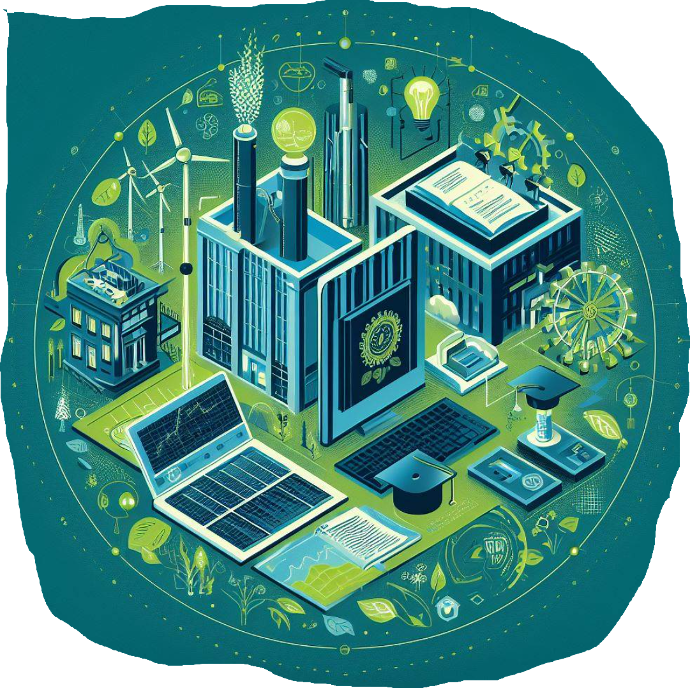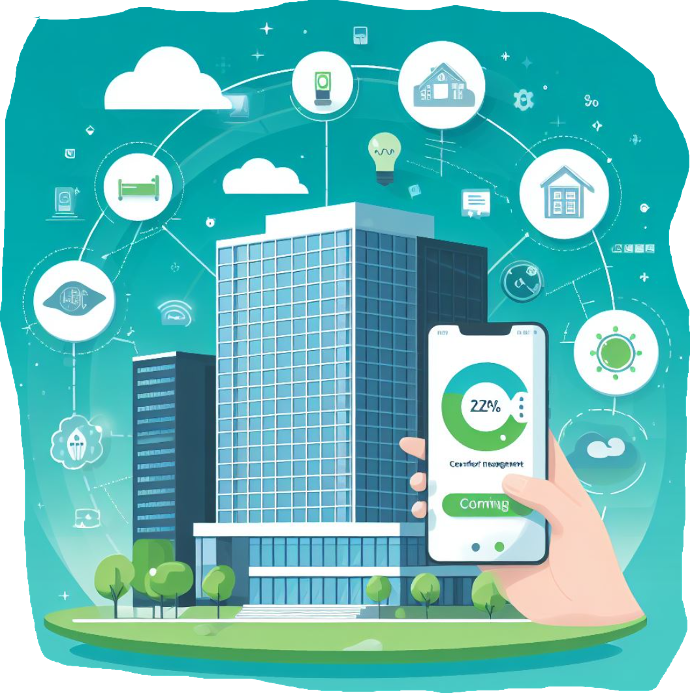Smart Building
Comfort and energy efficiency for buildings

A committed approach for an intelligent building, integrating the 4th fluid (data)
"Smart Building, a profitable solution to meet the tertiary decree. ROI between 4 months and 4 years"

Compliance
Goal
The challenge of energy sobriety is to promote the ecological transition of the tertiary sector, which represents approximately 40% of final energy consumption and 25% of greenhouse gas emissions in France. These decrees also aim to improve the comfort and quality of life of occupants of tertiary buildings, as well as to reduce the operating and maintenance costs of equipment.
Tertiary Decree
The tertiary decree aims to reduce the energy consumption of existing buildings in the tertiary sector by 40% by 2030, 50% by 2040 and 60% by 2050 compared to 2010. It concerns buildings or parts of buildings for tertiary use of more than 1000 m22. It requires owners or occupants of these buildings to implement energy efficiency action plans and declare them on a dedicated digital platform.
BACS Decree
The BACS (Building Automation Control System) decree, resulting from decree no. 2020-887 of July 20, 2020, requires tertiary buildings to be equipped with an automation and control system such as GTB (Technical Building Management) or a BOS (Building Operating System). It aims to optimize the energy performance of heating, cooling and ventilation installations in tertiary buildings. It applies to new and existing buildings, according to variable power thresholds and deadlines.
CEE aids
CEE aids are bonuses paid by energy suppliers to players in the tertiary sector who carry out energy saving work in their buildings. There are many operations eligible for CEE aid, such as insulation, heating, lighting, ventilation, etc. To benefit from CEE aid, you must respect certain conditions, such as calling on a qualified professional, choosing high-performance equipment, declaring the work on the Éco Énergie Tertiaire platform, etc.
Heating-Ventilation-Air Conditioning (HVAC)
The BACS decree concerns all non-residential tertiary buildings, new or existing, for which the heating or air conditioning system, whether or not combined with a ventilation system, has a nominal power greater than 290 kW (by January 1, 2025 ) or 70 kW (by January 1, 2027). There are three types of regulation of HVAC-Refrigeration equipment to meet the requirements of the BACS decree: local regulation, centralized regulation and optimized regulation.
Local regulation
Local regulation consists of adjusting the temperature and air flow according to local needs, using thermostats, probes or presence detectors.
Centralized regulation
Centralized regulation makes it possible to control and supervise HVAC-Refrigeration equipment from a central station, using technical building management software (BMS).
Optimized regulation
Optimized regulation makes it possible to optimize the operation of HVAC-Refrigeration equipment according to external conditions, occupancy times, energy rates or environmental constraints, using intelligent algorithms or artificial intelligence.


Access-Openings-Security
Access and opening management is an important function of building automation and control systems (BACS), which allows temperature, ventilation and lighting to be regulated according to the presence and needs of occupants. It thus contributes to energy sobriety, which is the objective of the BACS decree and the energy consumption reduction plan announced by the government.
Access and opening management can be done in different ways, depending on the level of performance and complexity of the BACS system installed. For example, this could be:
- Detect the opening or closing of doors and windows, and adapt the operation of heating, air conditioning and ventilation equipment accordingly, to avoid unnecessary heat losses or gains.’ouverture ou la fermeture des portes et des fenêtres, et adapter en conséquence le fonctionnement des équipements de chauffage, de climatisation et de ventilation, pour éviter les pertes ou les gains de chaleur inutiles.
- Control access to different areas of the building, and activate or deactivate heating, air conditioning, ventilation and lighting equipment, based on occupancy times, access rights or predefined scenarios.
- Optimize opening or closing of blinds, shutters or sunshades, depending on the sunshine, the outside temperature, the interior brightness or the visual comfort of the occupants.

Comfort (lighting-multimedia)
Comfort management (lighting, multimedia) is another function of building automation and control systems (BACS), which makes it possible to create light and sound environments adapted to the activities and preferences of occupants. It also contributes to energy efficiency, by optimizing the consumption of light sources and multimedia devices, depending on presence, natural light, sound level or mode of use.
Comfort management (lighting, multimedia) can be done in different ways, depending on the level of performance and complexity of the BACS system installed. For example, this could be:
- Detect the presence or absence of occupants, and turn light sources and multimedia devices on or off, based on occupancy times, access rights or predefined scenarios.
- Adjust the intensity, color, temperature or direction of light sources, depending on the activity, visual comfort, mood or identity of the occupants.
- Control the volume, source, broadcast or synchronization of multimedia devices, depending on the type of content, hearing comfort, ambiance or occupant demand.
Comfort management (lighting, multimedia) makes it possible to achieve significant energy savings, by reducing the consumption of light sources and multimedia devices, while ensuring the comfort and well-being of occupants.